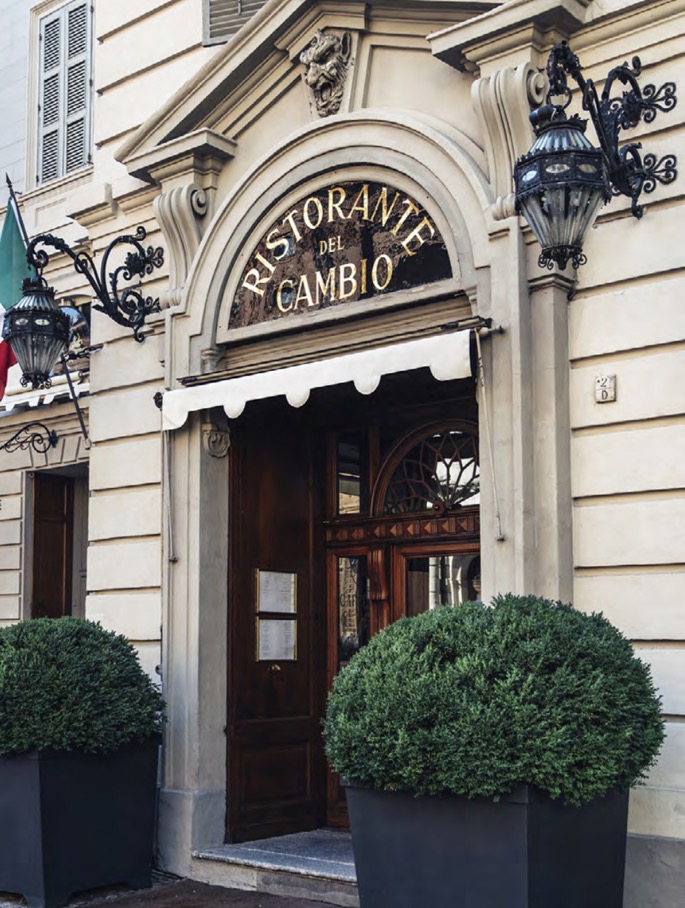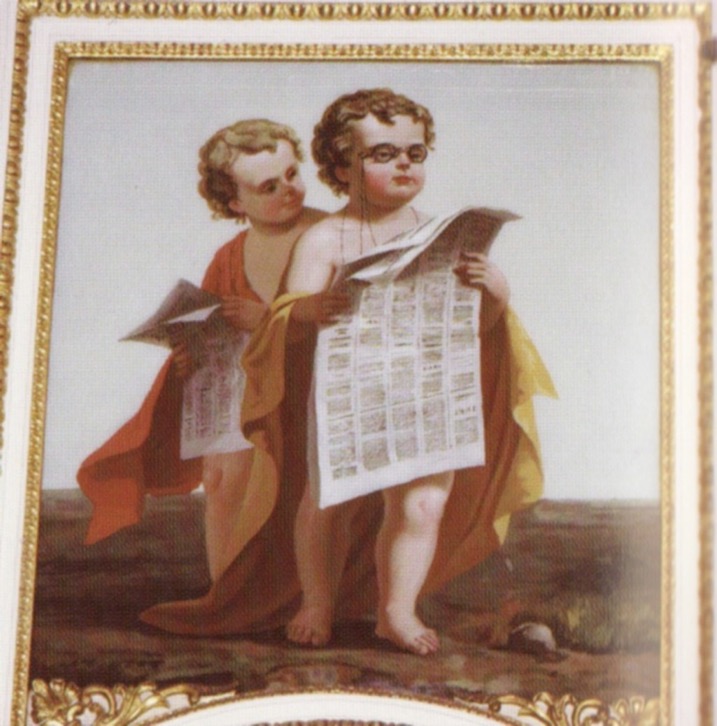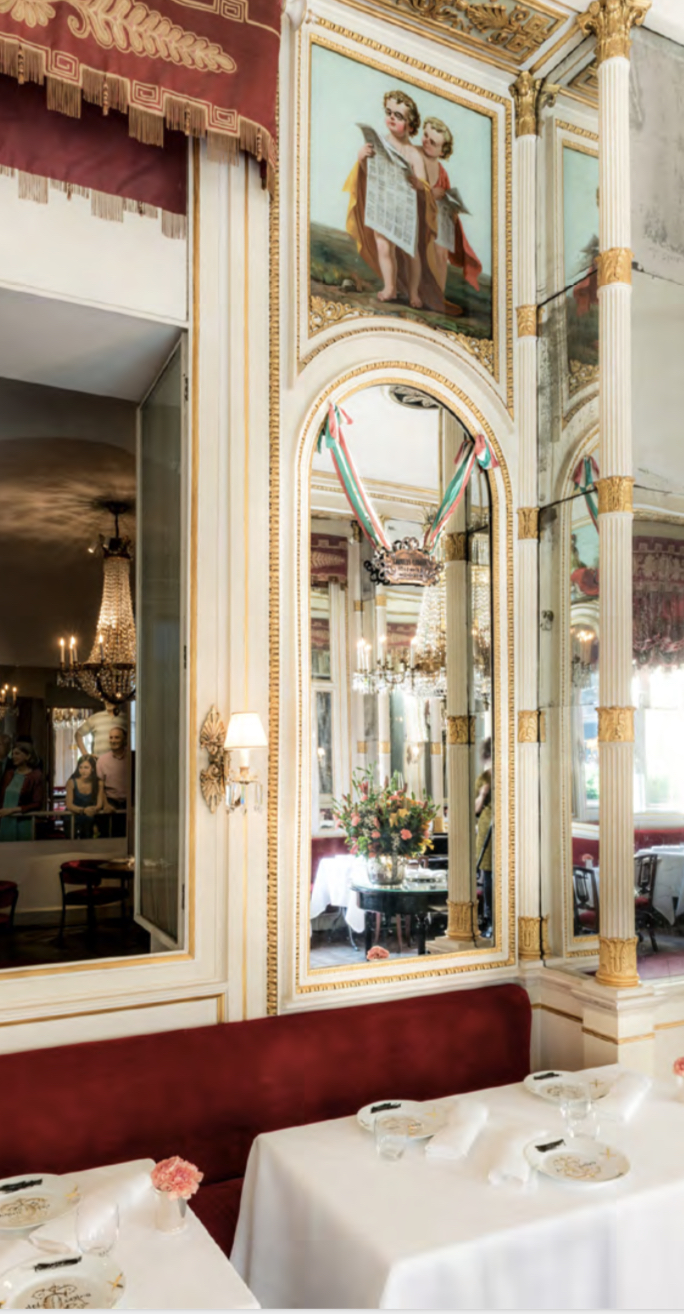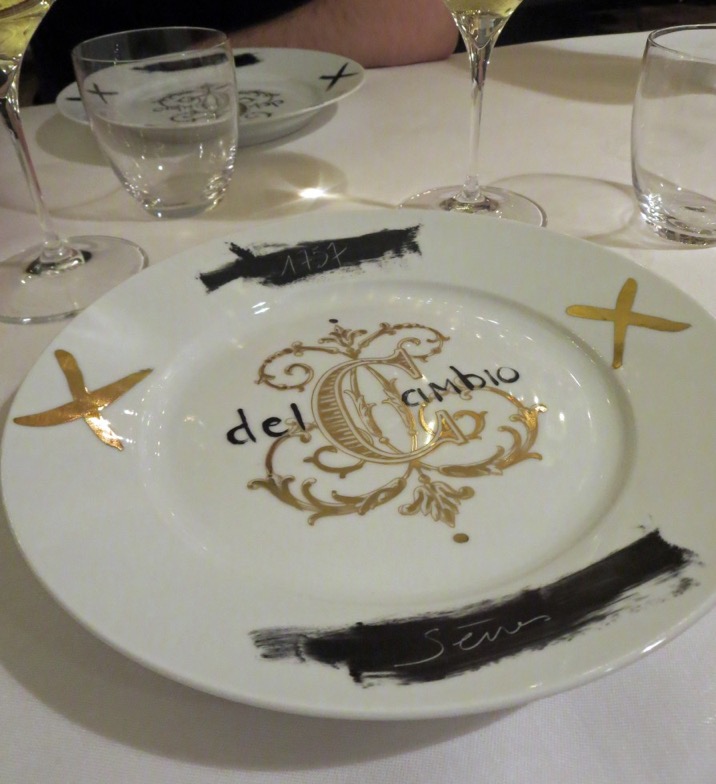Ristorante Del Cambio, Turin
last update: 20 Nov. 2019

During our short stay in Turin, we were fortunately to be invited by some friends to lunch at the emblematic Restaurant 'Del Cambio'. Today Del Cambio is a 1![]() Michelin restaurant, and home to the modern skills of Matteo Baronetto. However the restaurant has a history of more than 260 years, and has welcomed personalities such as Giacomo Casanova, Wolfgang Amadeus Mozart, Carlo Goldoni, Giacomo Puccini, Honoré de Balzac, Friedrich Nietzsche, Giuseppe Verdi, Filippo Tommaso Marinetti, Gabriele D'Annunzio, Pauline Borghese (sister of Napoleon Bonaparte), and more recently Maria Callas, Audrey Hepburn and the Agnelli family.
Michelin restaurant, and home to the modern skills of Matteo Baronetto. However the restaurant has a history of more than 260 years, and has welcomed personalities such as Giacomo Casanova, Wolfgang Amadeus Mozart, Carlo Goldoni, Giacomo Puccini, Honoré de Balzac, Friedrich Nietzsche, Giuseppe Verdi, Filippo Tommaso Marinetti, Gabriele D'Annunzio, Pauline Borghese (sister of Napoleon Bonaparte), and more recently Maria Callas, Audrey Hepburn and the Agnelli family.
It's easy to pull out of a hat a list of famous names with the suggestion that they would have enjoyed the pleasures of this or that restaurant. However, we do know that Casanova fled from Venice in 1759 (fuga dai Piombi di Venezia), and stayed repeatedly in Turin between 1760 and 1769. For example, in 1760 he stayed with his friend Ercole Gian Antonio, Marchese Turinetti at 156 Piazza San Carlo (the splendid Palais Turinetti was just a couple of minutes from Del Cambio) and Casanova actually mentioned the coffee shop in his memoirs. Ercole Turinetti was known for his gambling and is said to have often appeared in public with both his wife and his mistress at his side. The Marchese Turinetti was also known to be a useful source of prohibited literature during the 1770's. The Marchesa Gabriella Falletti di Villafalletto, wife of the Marchese, was of a "bellezza non ordinaria", and is known to have 'inspired' Vittorio Alfieri (she was his 'odiosamata Signora'). It is said that Casanova did court the Marchesa, but having "andato in bianco" (got nothing), he remained a firm friend of the Marchese at the gaming tables and "in altre avventure". In his writings Casanova makes it abundantly clear that he enjoyed himself with numerous conquests in Turin.
It's not surprising that Casanova's escape from the prison of the Serenissima would attract the attention of the Savoy police (Polizia Sabauda). And we know that Francesco Flaminio san Martini, Conte d'Aglié (Vicario di polizia), actually ordered Casanova to leave Turin, but this order was revoked by Cavaliere Riberti, the then Segreteria degli Esteri (Secretary of Foreign Affairs). In fact Casanova wrote concerning Turin "Fra le città d'Italia, Torino è quella nella quale il bel sesso ha tutti i suoi fascini che l'amore gli può desiderare, ma la polizia, a Torino, è più fastidiosa che altrove. Siccome la città è piccola e molto popolata, vi sono spie dappertutto. Quindi per potervi godere di una certa libertà, si devono usare grandissime precauzioni, ricorrendo a mezzane molto abili, che si fan pagare molto bene perché rischiano di essere barbaramente punite se vengono scoperte...". Who knows, maybe it was in Del Cambio that Casanova wooed some of his future conquests (he does occasionally mention Del Cambio in his memoirs).
In reading through some the background texts not directly related to Turin, I came across a term I had not encountered before, i.e. cicisbeo (plural cicisbei). Wikipedia tells us that it is an 18th C and 19th C Italian term for a man who was the professed gallant or lover of a woman married to someone else (with the knowledge and consent of the husband). The Wikipedia article suggests that it was widely practiced in Genoa, Nice, Venice, Florence and Rome, even if the exact nature of the practice was not well defined. In many ways we are talking about a dandy or flirt that at least in the 18th C had a very specific social role, i.e. an 'official' lady's escort that was not synonymous with adultery. However, the Anglo-Saxon view was more along the lines of a legitimisation of equal access to married women. In 18th C Italy a man could only have one wife, and could not have casual sex with another man's wife. So what would cicisbeo mean in the world of Goldoni or Alfieri? Well, in Milan in the 1760's, an unmarried young (idle, privileged, extravagant) nobleman would escort a married lady. He was expected to think of her during his elaborate toilette, then visit her for lunch. He would sit next to her and flirt, whilst her indifferent husband allowed him to order around his household servants. In the afternoon our young nobleman would accompany the lady for a walk in the main streets of the Milan, and engage is gallant conversation with other ladies and their escorts. In some/many cases this would allow the husband to visit his mistress, or even accompany another lady in her afternoon walk. Our young nobleman would then accompany his lady to an evening reception followed by cards or other society games. He would return the lady to her home in the middle of the night. Naturally in the minds of some this left an opportunity for "nocturnal conversations which offer many opportunities for offending the Lord God and losing one's soul". We must not forget that if we return to the period of Goldoni 'conversazione' meant much more than a quick chat.
Wikipedia suggests that cicisbei in Genoa, Florence, Rome, etc. was more or less the same, and this is far from true. This is not the place for a lengthy discussion but in Rome cicisbei was an integral part of the art of gossip in the city. So we see a city mixing and matching both chaste and honoured 'conversazioni' with a whole variety of other 'suspicious relationships'. Cicisbei in Rome was a mix of 'service' and 'friendships' whereas in places like Genoa and Florence it was more a way to organised relationships through a tightly knit network of reciprocity. However it is said that in Turin the Court actually assigned to the gentlemen the duties of serving the ladies present at one or other evening, i.e. the 'conversazioni' of Piedmontese nobles were to a certain extent controlled by the sovereign. Private salons did emerge in the later part of the 18th C, but when compared to Genoa, Venice and Florence, cisisbeoism was much the fashion in Turin and quite widespread.
I've not been able to verify the link between many of the other famous people listed above and the restaurant. However we do know that Mozart was in Turin in January 1771 for a very short visit and Balzac spent 2 weeks in Turin in July 1836, so who knows. We also know that Nietzsche found Turin "a paradise for the feet" in April 1888 and again in the autumn of the same year. It was also in Piazza Carlo Alberto in 1889 that he suffered a breakdown, but I can find no specific references to Nietzsche visiting the restaurant Del Cambio. Here is an excellent description of the period Nietzsche spent in Turin.
You can imagine that the 'greats' of Italian culture, Goldoni, Puccini, Marinetti, D'Annuncio, would have obviously frequently visited Turin, but I've not found a particular link to the restaurant Del Cambio. In fact I would have thought that Marinetti, the author of 'Il Manifesto del Futurismo', would have kept his distance from 'institutions' such as Del Cambio (but today I'm also certain that Marinetti would be an avid fan of Baronetto). However Verdi did visit Turin in 1859 and met with Cavour on the 17 October. Cavour tried to convince Verdi to run for political office, and in fact Verdi was elected on the 3 February 1861 to the Parliament of Piemont-Sardinia in Turin. Pretty good chance that Verdi would have dined, at least occasionally, at Del Cambio.
Pauline Bonaparte became Pauline Borghese by marriage in 1803 and when in Turin lived in Palazzo Chiablese, but I doubt that a powerful noble family would find much interest in dining in a local coffee shop. I can't find any link between Del Cambio and either Maria Callas or Audrey Hepburn, and whilst Agnelli is synonymous with Turin and FIAT, I have not been able to link that name to Del Cambio.
What is in the name 'Del Cambio'?
Some experts have suggested that it was a place where the mail horses were changed in the trip between Italy and Paris. Others have suggested that it was more probably linked to 'il cambio della moneta', or money exchanged because the piazza was known as a place frequented by business and commercial people. Some historians think that the original coffee house was a place where shopkeepers trade their goods, i.e. 'Consolato de' Cambi, Negozi ed Arti di Torino' (Market for exchange, shops and arts of Turin) which was usually headed by the confectioners and distillers of brandy (confettieri e distillatori d'acquavite).
They say that the restaurant is a cultural and historic symbol that has survived and remained current since 5 October 1757.

The restaurant is located in Piazza Carignano, 2, in front of the Palazzo Carignano. This palace was the seat of Italy's first parliament, newly unified on 18 February 1861 (the building is today the Museo del Risorgimento). At best, most documents simply note that the restaurant was part of the 'Theatro Carignano'.
The early history of the restaurant is in fact far more picturesque. Until ca. 1700 the site was occupied by a rectangular building with red walls dedicated to the game of 'pallacorda' (called 'trincotto' or real tennis). In 1663 the building had been sold by the Compagnia di Gesú to Emanuele Filiberto di Carignano. He also acquired that land nearby in order to create the first Piazza. His son Luigi Amedeo di Carignano inherited the 'trincotto' and transformed it in 1712 into a theatre called 'Teatro di Sua Altezza Serenissima il Signor Principe di Carignano'. The theatre was said to have been a family affair, open every evening to the prince and his family and guests. It was Luigi Amedeo who would host shows such as 'il ballo di corda' (rope dance) and 'il ballo di spada' (sword dance). Only in 1727 did it begin to host prose, songs and ballet performances. When the first theatre collapsed in 1752 a new one was built in brick according to the project of Benedetto Alfieri. The new theatre would have 84 loggias and three ranks of benches in the stalls. It was covered in richly decorate stucco and illuminated by candle. In 1752 the new project was so costly that Carignano was forced to sell the land nearby to Capomastro Fontana. The new plans included buildings on both side of the theatre, and including two arcades. The Café Del Cambio can be dated back to this period (1757).
Already in 1711 the 'Teatro Commedia nel Trincotto' was serving drinks, and by 1721 there was a 'bottega di acquavitario' at the theatre entrance. A 'Bottega del Café' is mentioned in 1786 when the theatre was rebuilt after a fire. But we have to wait until 1790 to see the mention of a "aquavitario e confettieri della bottega detta de Cambio". We know that numerous comedies of Goldoni were played at the new theatre, as was a piece by Molière. The theatre continued to attract the crowds, for example in 1884 Eleonora Duse had her first triumph there with Giovanni Verga's opera Cavalleria Rusticana (Eleonora Duse has the dubious privilege of giving her name to the shortest street in Turin). Then in 1886 Arturo Toscanini made his debut in the theatre, and later it hosted the first performance of Luigi Pirandello's 'Il Piacere dell'Onestà' (The Pleasure of Honesty).
It was in 1846 that the Café Del Cambio underwent a major transformation. Two dining rooms were added and the arcade was enclosed by two imposing verandas creating the 'Sala Cavour'. In 1840 the bottega was one of the first to install gas lighting, and it was at this moment that 'Del Cambio' became famous for its guests drawn from the theatre and the 'Camera dei Deputati' in the Palazzo Carignano.

In 1875 the ceiling was decorated by Roberto Bonelli and the panels over the doors depicted the four seasons. An additional panel was added with a caricature of the babies Costantino Nigra and Camillo Benso with glasses, both intent on reading the newspapers.
Over the years ownership changed numerous times, and in 1973 the Society Publiosa, Cinzano, invested in a major restoration project to bring the dining rooms back to their original decoration with the mirrors, chandeliers, neo-classical tables of white marble and red velvet upholstery. Later the restaurant was closed after the then owns, THI, were forced in to bankruptcy. The restaurant was later bought by Michele Denegri, a businessman behind the holding Finde, and opened again in 2014. This time the historical dining spaces were extended with a variety of alternative, more modern, dining spaces. The exterior is modelled on a photograph from the 1920's and the Sala Risorgimento was restored (again) to the original plan from the 1800's.

It would be indelicate to mention Cavour and not mention Palazzo Carignano, which was used from 1848 to 1861 as the 'Camera dei Deputati del Parlamento Subalpino' (Chamber of Deputies of the Subalpine Parliament). The Palazzo dei Principi di Carignano, to give the building its full name, was in the style of 'barocca piemontese', and was built between 1679 and 1684. Its curved brick façade, built on two floors, makes it unique throughout Turin. It was built to the orders of Emanuele Filiberto di Savoia-Carignano ('il Muto') and the architect was Guarino Guarini. The future kings of Italy, Carlo Alberto and Vittorio Emanuele II di Savoia, were both born in this palace. When Carlo Alberto ascended to the Italian throne he ceded the palace to 'Demanio' (State Property), and it became the home of the Consiglio di Stato (Council of State) and the Direzione delle Poste (Directorate of the Post). In 1848 the central 'salone delle feste' was redesigned as a parliament chamber, but with the creation of the first Italian Parliament in 1861, the space was found to be too small. The architect Domenico Ferri was asked to extend the building towards Piazza Carlo Alberto. The work started in 1863 and was finished in 1871, and during that time the parliament sat in a temporary building in the central courtyard. However, given that the Italian capital was transferred to Florence in 1864, the new parliament chamber was never used. However the building will always be part of Italy's democratic heritage, for it was there that Vittorio Emanuele II proclaimed the birth of the Kingdom of Italy.
The restaurant
So the restaurant was reopened in 2014 and offers a variety of dining options for visitors and groups, from a cantina 12 metres underground and more than 500 years old to the famous Sala Risorgimento.

We were privileged to sit at a famous table in the Sala Risorgimento, the table of Cavour.

History tells us that during the Risorgimento Camillo Benso, Conte di Cavour, would occupy his regular table at the restaurant Del Cambio and enjoy his 'Finanziera'. In a guide book published in 1852 the authors note that every day, before discussing the high affairs of the nation, you could find sitting on the restaurants' benches 'onorevoli deputati' (honourable Members). Without party political distinctions they would 'provvedere agile interesse del loro stomaco' (satisfy the interests of their stomachs) before satisfying the interests of the State.
The name of his favourite dish 'Finanziera' suggests a 'power meal' of rich ingredients and elaborate culinary skills. But we are far away from the truth. Initially, in 1450, it was a pastel of chicken liver, testicles and crests or cockscombs. But over time it became a dish born of the need to use the offal of chickens and calves. It was usually prepared in spring and summer, the period when chickens were castrated to become capons, and where crests and wattles were available (these are the most representative part of the dish). The question is of course, why call such a dish 'Finanziera'? One suggestion was that the tax inspectors would check a farmers giblets and offal as a way of determining the tax that should be paid. And naturally some of the giblets and offal would find their way into the hands of the tax inspectors, who would then prepare the dish. Over time the dish evolved. In one form it remained a kind of ragout or companion sauce for pies or tartlets (sometime even enriched with truffles). In another form it simply became a dish on its own. And in Turin it became a lunch consumed by elegantly dressed politicians, bankers, and financiers. It is said that every Piedmontese family must have a version in their receipt book.
Our meal

We sat down in front of a place plate, a Sèvres plate from the old restaurant, but recently 'reinvented' to underline the modernity of the new chef.
Our lunch started with a 'calice frescho' of the 'house' Spumante Cuvée Del Cambio 2012, accompanied by a variety of interesting looking snacks, etc.

This is just one example from a cave of 20,000 bottles, and 2,200 references (a wine card that is considered to be one of the best in the world, and includes 140 Champagnes).

My starter was the excellent house foie gras, and I followed that with one of the chef's signature dishes, the so-called Riso alla Cavour. It's interesting to note that the dish was named after Cavour, but that you can also obtain rice from Leri Cavour, a place in the Provincia di Vercelli where Camillo Benso owned considerable lands.
It is said that Cavour enjoyed eating 'pasticcio', which is a generic name for a variety of savoury pies. What Cavour ate was boiled and sautéed English rice mixed with ripe tomato pieces and eggs. It would then be sprinkled with roast sauce and baked 'au gratin', and served warm (not hot) with a sprinkle of Parmesan cheese. This was not an easy dish to digest, and so now Baronetto has created a new dish with that tradition in mind. He has added just a touch of confit tomatoes, more for colour than taste. The rice is mixed with pan fried black rice to add a crunchy touch, and the mix is served over a hidden egg. So the first thing to do is to mix the rice and egg, to create a kind of risotto with a firm consistency. Very enjoyable, and the key is the rice and egg mixture for the taste and the crunchy black rice for the texture.
I suppose the highlight, at least in terms of visual effect, were the desserts.

My wife decided on a dessert based upon (if I remember correctly) the passion fruit, whereas our friends preferred chocolate.


My preference was for Madagascar vanilla, where the profile of the island was outlined against the blue of the Indian Ocean.

As a conclusion, what can we say. A truly fantastic experience, and one that I would like, as Cavour did, to repeat every day.